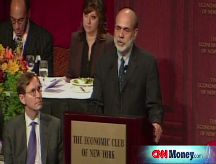Will the Fed go below 1%
Ben Bernanke & Co. are likely to cut interest rates again on Oct. 29. And some experts think rates could soon fall below 1% for the first time.
NEW YORK (CNNMoney.com) -- The Federal Reserve is widely expected to cut interest rates again this week. But could the Fed soon go where it has never gone before and bring them below 1%?
The Fed lowered its federal funds rate, the benchmark overnight lending rate at which banks lend to one another, by a half-percentage point to 1.5% in an emergency announcement Oct. 8.
Many investors believe the central bank will cut rates by at least another half-percentage point following the end of a two-day meeting on Oct. 29.
In fact, the fed funds futures on the Chicago Board of Trade are now pricing in a 26% chance that the Fed will cut rates by three-quarters of a percentage point to 0.75% by that meeting.
Fed Chairman Ben Bernanke has said in recent weeks that economic weakness is likely to continue into next year, despite rate cuts and other recent moves taken by the Fed and Treasury Department to try and fix the credit crisis.
Last week, Bernanke pushed Congress to consider a new stimulus plan to spur the economy.
"Everyone at the Fed has pretty much told you they're going to cut," said Rich Yamarone, director of economic research at Argus Research. "They're in a kitchen sink mode right now. Rate cuts, fiscal stimulus, bailouts - they're throwing everything they can at this right now."
Still, would the Fed really consider lowering interest rates below 1%? The last time rates were at 1% was between June 2003 and June 2004.
Rate cuts have been a key tool the central bank has used in the past to boost a weak economy. A variety of lending rates, including credit cards and home equity lines, as well as the prime rate used to set many business loan rates, are pegged to the fed funds rate.
So lower rates usually lead to cheaper credit, thus spurring businesses and consumers to spend money more freely.
But in the current credit crisis, with banks afraid to make loans due to worries about their firms' own need for cash in the near term, already relatively low short-term rates have done little to get credit flowing. (The Fed cut rates seven times between September 2007 and April before holding them at 2% for several months.)
Some economists argue that another rate cut may be the least important step the Fed can take in its effort to solve the crisis.
"It's window dressing, only a psychological weapon," said Sung Won Sohn, economics professor at Cal State University Channel Islands. "Right now, the problem isn't the cost of the Fed's money, it's that the existing money supply is not circulating. The pipelines are clogged."
Even Fed Vice Chairman Donald Kohn seemed to acknowledge that rate cuts aren't as important as they once were. In an Oct. 15 speech, Kohn said the coordinated global cut the previous week had already been "overwhelmed ... by the further erosion in confidence."
Still, many economists say that fear and uncertainty in the markets is so great right now that the Fed can't risk leaving rates unchanged. And they say anything that can be done to spur lending is a positive.
"It's not irrelevant, even if it's not as important as usual," said David Wyss, chief economist with Standard & Poor's.
Wyss said that if the U.S. credit and financial markets remain in crisis, a cut below 1% could come later this year or early next year.
To be sure, some have pointed to rates being at 1% for as long as they were as a factor in the housing bubble earlier this decade. It was the plunge from those inflated home values that sparked the credit crisis now dogging markets.
Low rates can also feed inflation. But that might be a sacrifice the Fed has to make.
"Inflating our way out of this mess is the Fed's only option at this point," said Peter Boockvar, market analyst of Miller Tabak, in a note Friday morning.
With the global economy slowing down, there are few economists talking about the threat of inflation. And the continued decline in home prices has negated most fears of low rates leading to another housing bubble.
So even a cut to nearly 0%, a rate where the Bank of Japan left rates for much of the 1990's, is not out of the question, given the unprecedented nature of credit problems.
"There's a hesitation to do it because it looks like desperation. But they're getting desperate," said Wyss. ![]()




